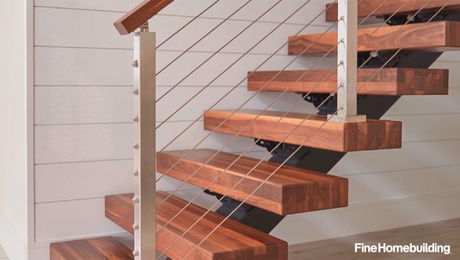Just installed a gas hot water heater.
Went pretty well except for the 3 days my wife had without a shower (I’ve got one at work).
Remembered that Peter Hemp had written an article about doing same, found it in the archives and downloaded it to see if I missed anything (SWMBO had thrown out the old FH collection during garage cleanup).
He says no teflon tape on gas lines. I had bought some yellow teflon tape (supposedly for gas lines at the local big box, and used it with pipe dope to put the gas line in. Here they don’t like flexible lines, so it was all rigid pipe. No leaks. Is this kosher? Do I have to re-plumb?
While I’m at it, while using plumbing unions, do you put dope on the actual milled face of the union? I just put it on all the threaded connections. No leaks.
Should I wrap this hot water heater? The instruction book says you don’t have to and was somewhat discourgaging.
Thanks for any/all answers,
Ben
Edited 10/21/2004 9:58 am ET by Ben


















Replies
I think the big issue about using Teflon tape is not the possibility of leaks, but the possibility of little pieces getting loose inside the pipe and clogging things up. If a person puts it on properly (wrapping it the right direction, not putting on too much, and making sure there aren't any loose strings hanging inside the fitting) I don't know why it wouldn't work OK.
Did you put in a vertical "drop" in the line? They're designed to catch any debris that might be in there.
If you don't hear it, you got hit, so never mind.
"Did you put in a vertical "drop" in the line? They're designed to catch any debris that might be in there."There wasn't a debris trap originally, but I plan to put one in. The vertical where it would be easy to do is before the valve, so I have to shut off the whole house gas to put one in.
I don't know anything about that article ...
but don't trust everything you read.
here or in the mag.
That said ... yellow "gas" tape is just fine.
me .. my plumber .. and the inspectors all agree.
the author probably was cautioning about using "regular" teflon tape and his thoughts got "edited" down.
Jeff
To paraphrase Tip O'Neil ("all politics are local"): All Building Codes are Local.
Several schools of thought:
Gas leaks are bad, tape AND dope offers Belt and Suspenders.
Stuck open orifices are bad, tape can shred, so don't use tape.
Drop legs catch stuff, drop legs are good.
I like gas-pipe tape (properly applied) AND dope AND drop legs. So does my inspecter (former plumber) but he only insists on the pressure test, however you pass that.
My gas company 1) are a bunch of paternalistis jerks, 2) don't want tape, 3) yet don't insist on drop legs, and 4) feel that they trump the city inspector. I try to get gas service established early, as soon as I have a appliance plumbed in, so as to get them out my hair ASAP.
Short answer (unless you're on a crusade): Ask the inspector. Ask the gas company. Take notes and name names. Find the overlap of their requirements.
Anybody who knows,
So what is the difference between yellow and white teflon tape (besides the color)?
WSJ
I think that I know is that the tape comes in several different thickness. I think that the yellow is one of the thicker ones.
I use the yellow for motorcycle tank fittings because the white melts in gasoline.Beat it to fit / Paint it to match
the white is not for Gas--The yellow is different color because It has a differect formula to be resistant to the gas and not degrade. White will degrade and drop flakes into the pipe if it is wrapped poorly--Please don't use white tape for gas.In my understanding in days gone by when gas had more moistrure in it they put the dropps in to catch the condesation. the water vapor would stay in gas till it got to the warm houses and condesate on the inside of the pipe. The drops would hold it and allow it to evaporate into the gas slowly .
Here's one subject that I can talk about with authority. My company works with gas, vapour and liquid pressure and vacuum services that make commercial natural gas service a piece of cake in comparison.
If it "melts" in gasoline or in natural gas, it ISN'T TEFLON! Teflon will hold gasoline or natural gas for a hundred years without dissolving! Teflon's inert to virtually every solvent, acid, base and gas known to man.
The only thing you can tell from the colour of a piece of teflon tape reliably is the presense or absence of DYE. You can't count on the colour to tell you anything. Pure teflon is WHITE.
What matters is the DENSITY of the teflon tape. Full density teflon tape is ~1.5 g/cm3. The yellow-dyed stuff that's marked "for natural gas service" is generally full- or nearly-full density teflon tape, with a density of between 1.0 and 1.5g/cm3.
The flimsy CRAP, orange or white, that you get at Home Despot and the like, has been stretched so much that it's virtually gone. It's 0.25 g/cm3 at best. That's why it's so CHEAP! It wraps easily, but it compresses away until there's nothing left. Seldom do people actually wrap enough of it onto a threaded joint to do the job properly.
The full density tape is harder, not easier, to apply- until you're used to it. It makes a far more reliable seal when you're done, particularly if you don't use an anaerobic pipethread sealant (dope, paste) in addition to the tape as a back-up sealant.
Tape and paste together are "belt and suspenders" for most plumbing applications. One or the other properly applied is enough. We use both because what we're sealing, nobody wants to let out...
Some people ban tape because of worries about tape debris plugging things up. It's a real problem, especially if you use the flimsy, cheap tape.
pink ...
ya forgot about pink!
Jeff
http://www.hydraulic-supply.com/pdf/356.pdf
here's a pretty formal layout of it all ...
Jeff
>ya forgot about pink!It's for the girl plumbers. Duh.David Thomas Overlooking Cook Inlet in Kenai, Alaska
Excellent expalnation on the gas tape issue. Fortunaly I got a roll of gas tape from my cousin who installes gas burners and such for pool spas etc. He lives in Fl. now so when I run out I don't know what I 'm going to do. I don't do much with gas but it is nice to have the right stuff on hand. boy your not kidding about that HD tape and how thin it is. I must go around 10-12 times to get a nice bead for water. Well, all is well with my connections so on with the show. thanks Mike
Edited 10/22/2004 2:27 am ET by mitremike
They way I was lernt The teflon tape is more of a thread LUBRICANT than a sealer.
the Dope is what seals the pipe.
the tape allows the threads screw together far enough to ensure a good connection.
Also I was lernt that brass fittings are soft enough to self seal.
But My "Plumbing Mentor" always uses both tape and Rector seal so thats what I do!
Mr T
I can't afford to be affordable anymore
Both tape and dope act as void sealers and lubricants. The tape is the better high-pressure lubricant- if it stays in place while the fitting is being tightened up, that is! If you choose the right pipe dope and use it correctly, it will actually do the better job of being a void sealer because it remains flexible and keeps the joint tight as it shrinks and enlarges with thermal cycling.
Don't confuse pipe dope with teflon, even if the dope has some teflon in it. They're nowhere nearly as chemical resistant as teflon tape is. Some of them are just modern versions of the limestone and linseed oil plumber's putty/paste that has been used for years. Most have some acrylic resin in them to replace the linseed oil and minerals like TiO2 to replace the limestone.
We do instrument air lines with dope only (because of the worry about plugging stuff with torn-off pieces of tape), some process chemical lines with tape only, and everything else gets both. For higher temperatures, we've found a grafoil tape that actually works too- shocking that it does. And there's always Expand-O as the last resort. Expand-O is a cementitious expanding pipe "dope" which is good for very high temperatures. It's a bit tricky to use properly, but when it's installed right it's very reliable- just hope you don't have to get the joint apart again later...
The cheap HD teflon tape feels "thin", but most of the low density tapes are actually just as thick as the full density stuff- until you squeeze them. Low density tape is just stretched/expanded so the same mass of teflon takes up more space, and hence it compresses away to nothing when you tighten down the joint. So don't be fooled by comparing just the thickness.
Molten,
Excellent explanation of the difference in tapes. I take it that high density tape still comes in white? I know it did years ago as I still have a fifteen year old roll. Real heavy, more than the yellow stuff.
Jon
White is all we buy. You can get white tape that ranges in specific gravity from 0.25 to 1.5. Remember that all these tapes are more or less the same "thickness", so don't go by this number.
guess the drop works well to catch any rust flakes too before they get into the works. Don't know how well they evarortate though. Mike
what about the pink tape ...
we keep forgetting about the pink ....
Jeff
Same as Dave Thomas except I don't like tape on steel pipe threads ever. Chews up the tape more often than not. Pieces get in the line and plug stuff up. Also the shreading often leads to leaks.
Drip leg a must. Use dope on steel pipe, tape on copper and brass. No dope needed on the milled face of the union but I know guys that do put some on the threads of the ring. I don't. DanT
While I'm at it, while using plumbing unions, do you put dope on the actual milled face of the union? I just put it on all the threaded connections. No leaks.
The milled faces of a union are tapered to seal like a valve. The threads at the union faces should not only not have pipe dope, but even better is to use a lubricant, like "never seize", to enable it to pull the two faces tighter together.
Marine Engineer
Thanks to all for the answers.I'm going to leave the tape on the threads and not disassemble. I used the HD yellow tape. I'm glad I did the union right - it seemed right to me at the time. I will add the drip leg.As usual, great answers at breaktime!
Everyone else seemed to weigh in on the teflon tape issue but what about those mags that got tossed? In a way I have the same problem but have issues of other magazines too.
Now JLC will sell you a CD with back issues on it. I have a set of two. There is a newer one but it must be gold plated or something. I got disc one. When the two disc set came out I got credit for having bought the first (not to mention the mag). Worked out great. Searchable by topic. Had all the mag covers on it too.
Now the newest one doesn't give any credit for buying disc one, then disc two, and the magazines. I suppose I could jack up prices or charge it off to a particular job but I don't work that way, refused, emailed them, and got a response that was so canned there should have been dog food in it.
There is a way (or was a way) and you could still clean out the garage.
Tyr
Hmmmmm Maybe this digital camera, mounted on a tripod....
Fine Homebuilding also culls out some favorites and will sell you the CD, but it's pricey.
I bought it online - $3.50! but cheaper if you buy in bulk.
Probably worth it if you save the best articles, throw out the rest, and buy the occasional one that you forgot to save.